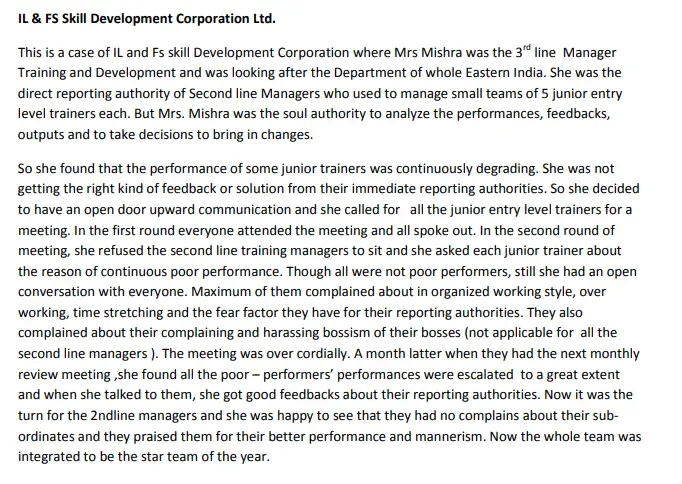In this blog, we will focus on the advantages and disadvantages of upward communication with a real example. The article further includes the characteristics and methods of upward communication with the frequently asked question on upward communication flow.
What is Upward Communication?
Upward Communication refers to the flow of information from the bottom level of the hierarchy in an organization to the top. It is a type of vertical communication since the message shared goes through all the levels of the organizational structure.
The information conveyed is usually an idea, suggestion, or feedback sent by the subordinates to their superiors. For example, an employee informing the manager about a customer’s requirements falls under upward communication.
Complaint and suggestion boxes, open-door policies, questionnaires, etc. are some channels of upward communication.
Must Read: What Is Upward Communication A Detailed Guide With Examples
Advantages and Disadvantages of Upward Communication
Unlike traditional methods, upward communication is new and gaining immense popularity for creating a healthy work environment. Given below are the merits and demerits of upward communication.
Advantages of Upward Communication:
1) Monitor Employees’ Performance and Receive Feedback
The upward flow of communication allows the employees to provide feedback to their superiors. This way, the managers can easily understand their requirements.
Moreover, they can gauge the performance of the employees via daily, weekly or monthly reports passed on to them. This is one of the crucial merits of upward communication as this creates scope for improvements.
2) Employees’ Grievances
Through complaint boxes or direct letters, employees can let their superiors know of the troubles or challenges face. They can express their dissatisfaction regarding any policy, safety procedures, work environment, etc.
Cases of discrimination, bullying, sexual harassment, or any type of injustice can also be reported via employee grievance.
3) Room for Suggestions
Effective upward communication encourages bottom-level employees to positively contribute to the company’s goals. This can be in the form of ideas, constructive opinions, past experiences, improvements, and so on.
Involving the ground-level staff is the best way to learn about your customers and their expectations, as well as the company’s functioning.
4) Completes the Two-way Process
While downward communication helps disseminate information from higher to lower levels, upward communication allows the opposite flow. This makes communication two-way and complete, thereby increasing its efficiency.
As a result, there’s mutual trust between all the different levels in the hierarchy, and maximum cooperation is achieved.
5) A Congenial Atmosphere
Another advantage of upward communication in an organization is that it ensures that the bottom-level employees feel heard and thus valued. The superiors get to know their subordinates better, thus creating mutual respect.
The labor-management relationship strengthens and a healthy harmonious environment is built. This introduces inclusivity within an organization and employee engagement peaks high.
6) Development of Plan
Without upward communication, the management can face numerous hurdles in decision-making and strategy development processes.
Collection of information, facts, statistics, market situations, etc., is imperative before implementing any changes. Even developing a new plan requires knowing the ground reports. All of this is possible because of the crucial benefits of upward feedback as it allows the bottom-level employees to be involved in the planning.
7) Helps Boost Creativity
Another advantage of upward communication is that it pushes the employees to hone their speaking and brainstorming skills. This guarantees them scope for improvement and learning and keeps them motivated.
The disadvantage of Upward Communication
Besides the numerous benefits of upward communication, there are some barriers to upward communication.
1) Unwillingness or Hesitation among Employees
Lack of confidence in subordinates and hesitation to speak for themselves to their superiors is the biggest limitation of upward communication.
Most bottom-level employees feel either shy or unenthusiastic to reach out to those at higher levels. For example, instead of clarifying a doubt with the manager, a worker might prefer asking their peer for help.
2) Distorted Information
To satisfy or impress the superiors, the subordinates can attempt to modify data and manipulate the original message. While this reduces the employees’ burden for some time, it’s unhealthy in the long run.
They start seeing responsibility as a burden and the company’s efficiency reduces due to insufficient information.
3) Fear of Superiors
Another disadvantage of upward communication in an organization is fear of superiors, which can also be the reason behind a subordinate’s hesitation to communicate. This may be due to past troublesome experiences, hearsay, or the superior’s unwelcoming behavior.
The employees might see sending feedback to their managers as rude or questioning the abilities of their superiors. They can even fear losing their jobs by communicating freely with those at the higher levels.
4) Time-consuming
Compared to downward communication, a lot of filtering of information takes place in upward communication. Due to the numerous levels that a message has to go through, the process gets delayed and becomes extremely time-consuming. This is the biggest problem with upward communication as it leaves the employees unheard and unmotivated.
5) Lack of Engagement of Superiors
It’s important that the employees feel welcome to strike up a conversation with their superiors, whether or not there’s an open-door policy.
If the managers show no interest in their employees and their situations, upward communication will turn out to be meaningless.
Moreover, the superiors might even pretend to listen or disregard the employee’s concern without paying much attention.
6) Flattery
Some employees can even consider upward communication as their chance to impress managers and executives. Thus, they may conceal the truth and pass on false information that’s sufficient to appear as a worthy asset of the company.
On the other hand, employees might even be forced to flatter their superiors with gifts so that their proposals get accepted, etc.
7) By-passing
Last, but not least, there’s a high risk of bypassing levels in the organizational hierarchy when the flow of information is upward.
For example, the employees may directly contact the department heads without informing their team leaders. This leaves the team leaders feeling unconfident and self-doubtful. Furthermore, it causes misunderstandings and hampers the labor-management relationship.
Methods of Improving Upward Communication
1) Open-door Policy
The open-door policy, in the simplest terms, means that the doors of management are always open for the employees. It aims to boost employee morale, establish mutual trust and create a harmonious workplace.
2) The Ombudsperson
The ombudsperson serves as a neutral bridge between the subordinates and top-level staff like executives and directors. The concept is to provide a safe place to resolve employee conflicts and injustice.
An ombudsperson is generally ideal for governmental organizations to prevent employees from lengthy bureaucratic procedures when reaching out for help.
3) Counseling Employees and Understanding Their Behaviour
Companies can hold exit interviews to find out the reasons and trends behind employee resignations. Private counseling sessions and attitude questionnaires are some ways to understand current employees and their behavior.
Upward communication example

The above image is a case example of upward communication used to improve the productivity of junior entry-level trainers. Mrs. Mishra third-line manager of training and development used the open-door method to interact with the junior trainer. Feedback in communication with the Junior trainer helped Mr. Mishra to escalate the poor performance.
Characteristics of Upward Communication
Unique characteristics of vertical upward communication:
1) Helps Understand Employees Better
Upward communication, when implemented successfully, always results in understanding the employees better. The superiors get to know their subordinates’ feelings, opinions, grievances, troubles, etc. This helps them to strive for achieving maximum employee satisfaction in the best way possible.
2) Gives Reactions to New Plans and Policies
Employees can easily share their thoughts on the latest company plans, policies, and changes with the management. This helps the top-level executives understand the pros and cons of their proposals and make the right decisions.
3) Reports, Feedback, and Suggestions Constitute the Communication Channel
The channel of communication process here is generally in the forms of reports, feedback, suggestions, direct letters, etc. Employees can also use complaint boxes or grievance letters to communicate their troubles at the workplace.
Objectives of Upward Communication
Given below are the objectives of upward communication:
1) Provides Feedback
Upward communication is necessary for any business to provide employee feedback to superiors. This allows managers to track employee growth and performance.
2) Introduces New Ideas
Subordinates get a fair chance of vocalizing their suggestions on different matters through upward communication. They can share constructive opinions and innovative ideas for the benefit of the company.
3) Creates a Sense of Belonging
Upward communication aims to relieve employees’ grievances and help them settle comfortably at the workplace. It promotes loyalty and drives employees to deliver their best for the organization’s welfare.
4) Collective Decision-making
The upward flow of communication provides the top-level staff with ground-level reports and information. This results in effective decision-making and successful leadership.
How does upward communication be the most significant tool in any organization?
Upward communication is an essential tool that bridges the communication gap between lower-level employees and top management. The managers are able to better understand the strength of their subordinates thus engaging them in the right direction.
Effective upward communication creates a centralized culture which results in better suggestions and recommendations from employees. However, the organization needs to be aware of the pros and cons of upward communication to manage the effective flow of communication in long run.
FAQs
Q1. What are the advantages and disadvantages of downward communication?
Ans: Downward communication helps implement order and organization within a company. It is useful in maintaining hierarchy and delegating authority among employees. However, the disadvantage of downward communication it fails to collect feedback from the subordinates, thus leaving them sidelined and unmotivated.
Q2. What is the disadvantage of upward information flow?
Ans: The upward flow of information might demand flattering and even bribing out of pressure, to impress superiors and get work done. This makes the employees hesitant to reach out to the managers even when there might not be such a case.
Q3. What is the main purpose of upward communication?
Ans. The main purpose of upward communication is to provide employee feedback to the managers. It aims to vocalize the subordinates to represent themselves and build a favorable working environment.
Q4. Why is upward communication difficult?
Ans: Upward communication is difficult because employees are usually either scared or hesitant to communicate with the higher-level staff. It may be due to a lack of confidence, fear of disapproval, impolite superiors, or lack of engagement from their side.



